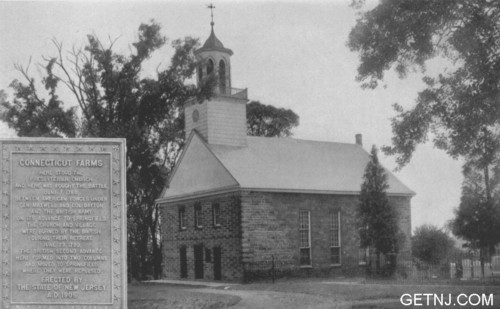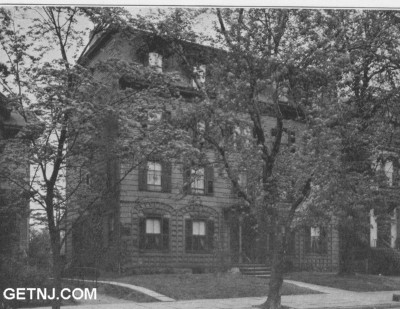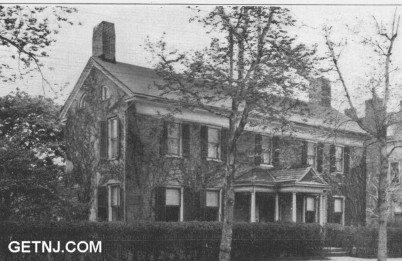Advertise Online
–
SEO - Search Engine Optimization - Search Engine Marketing - SEM
– Domains For Sale
– George Washington Bridge Bike Path and Pedestrian Walkway
– Corona Extra Beer Subliminal Advertising
– Outlaw Motorcycle Gangs
– Pet Care
–
The Tunnel Bar
–
La Cosa Nostra
–
Jersey City Free Books
From Historic Roadsides of New Jersey by The Society of Colonial Wars in the State of New Jersey, 1928
Edited by GET NJ, COPYRIGHT 2002
UNION COUNTY
 Church at Connecticut Farms (Now Union)
Church at Connecticut Farms (Now Union)
The Plaque Reads:
Connecticut Farms
Here Stood The Presbyterian Chruch and Here Was Fought The Battle,
June 7, 1780
Between American Forces Under Gen. Maxwell and Col. Dayton and The British Army on Its Advance to Springfield.
The Church and Village Were Burned by The British During Their Retreat
June 23, 1780
The British Second Advance Here Formed into Two Columns and Moved to SPringfield, Where They Were Repulsed
Erected by The State of New Jersey
A.D. 1905
Organized in 1857. Was formed out of Essex and Middlesex Counties. The English settled in the County in 1666 at
Elizabeth. Eighteen battles or engagements took place in Union
County in the Revolution. A list of dates and places follows:
|
Ash Swamp | May, 1777
|
| Ash Swamp |
June, 1779
|
| Connecticut Farms (Union) | June 7, 1780
|
| Connecticut Farms | June 23, 1780
|
| Elizabethtown | December 17, 1776
|
| Elizabethtown | January 25-30, 1780
|
| Elizabethtown | June 6, 1780
|
| Elizabethtown Point | July 21, 1778
|
| Elizabethtown Point | June 8, 1780
|
| Rahway Creek | September 30, 1777
|
| Rahway Meadows | June 26, 1781
|
| Springfield | December 17, 1776
|
| Springfield | February, 1777
|
| Springfield | October, 1779
|
| Springfield | June 23, 1780
|
| Spanktown (Rahway) | 1777
|
| Westfield | March 8, 1777
|
| Westfield | June, 1777
|
 Boxwood Hall, Elizabeth
Boxwood Hall, Elizabeth
ELIZABETH
Four miles from Newark. The Borough of
Elizabeth was incorporated February 8, 1739, and was the
first English and second permanent settlement in the State.
Philip Carteret, first Governor of East Jersey, landed at the
Point which he named Elizabethtown in 1665, in honor of
Lady Elizabeth Carteret, wife of Sir George Carteret.
The Colonial Assembly met here May 26-30, 1668, and
continued so to meet until 1682. In 1686 it met at Amboy,
and subsequently alternated between Amboy and Burlington.
December 1, 1774, Elizabethtown approved the recommendation of the Continental Congress regarding non-importation and non-exportation, and on February 13, 1775,
resolved to break off trade, etc., with Staten Islanders as unfriendly "to the liberties of America." Elizabeth suffered
greatly during the Revolution from Tory raids, and was the
scene of four battles or engagements, viz: December, 1776,
January 25-30, 1777, and June 6, 1780. Two other engagements took place at the Point July 21, 1778, and June 8, 1780.
Places of note:
- Hetfield House. Foot of Pearl Street, near Elizabeth
River, supposed to have been built 1667, conveyed to
Matthias Heathfield December 5, 1673. Still owned by his
descendants who spell the name Hetfield.
- St. John's Parsonage. 633 Pearl Street. Built 1696 by
Andrew Hampton. Purchased in 1749 by Trustees of
St. John's Church.
- Williamson House. Corner of Pearl and Williamson
Streets. Built in 1776. Now used by St. Elizabeth's Hospital. Home of General Matthias Williamson, Revolutionary officer, who was the father of Governor Isaac H.
Williamson and grandfather of Chancellor Benjamin
Williamson.
- The Old Chateau. 408 Rahway Avenue. Built 1760.
Home of Cavalier Jouet, grandfather of Chancellor
Williamson. Jouet was a descendant of Daniel Jouet of
Angers, France, and Marie Cavalier, a sister of the
"Camisard" Jean Cavalier, famous in the time of Louis
XIV. Cavalier Jouet was a Tory and his property was
confiscated.
- DeHart House. 101 Rahway Avenue, corner of Cherry
Street. Built 1766. Home of John DeHart, member of
the Continental Congress and Mayor of Elizabeth.
- Site of Red Lion Inn. Broad Street and Rahway Avenue.
Now occupied by Public Library. Inn built about 1734.
In 1764, called Marquis of Granby. In 1771 name changed
to "Red Lion." General Washington on the way to his
first inauguration stopped and held a reception at the Red
Lion.
- Boudinot Mansion or Boxwood Hall. 1073 E. Jersey
Street. Probably built about 1750. Home during Revolution of Elias Boudinot, who, as President of the Continental Congress, signed the treaty of peace with Great
Britain. The body of Rev. James Caldwell, murdered by
the British at Elizabethtown Point, was exposed to the
view of the Revolutionary Army on the steps of this house
and Boudinot made an address. Home owned subsequently
by Jonathan Dayton, Speaker of the United States House
of Representatives and United States Senator, for whom
Dayton, Ohio was named. Lafayette entertained here in
1824. Now "Home for Aged Women." Marked by
bronze tablet placed by the Boudinot Chapter, D.A.R.,
1899.
- Carteret Arms. 16 S. Broad Street. Used as a tavern prior
to 1728. Resort of British officers. Purchased in 1913 by
the Elizabeth Historic and Civic Association, now occupied by the Woman's Club.
- Graham's Tavern. Northeast corner Broad and Jersey
Streets, also known as City Tavern. Noted for the prominent persons who patronized it, including Dr. Barnet,
Lord Stirling, Judge Chetwood, Matthias Williamson, and
others.
- General Scott House. 1105 E. Jersey Street. Home of
Dr. William Barnet, Revolutionary Surgeon, built 1763.
Plundered by the British in 1781. Later owned by Colonel
John Mayo of Richmond, Virginia, whose daughter became wife of Lieutenant General Winfield Scott.
- St. John's Church. Broad Street. Organized by Rev. John
Brooke, cornerstone laid June 24, 1706. Incorporated by
Royal Charter 1762. Present church erected 1859. Font
presented by Cavalier Jouet. Rev. Thos. Bradbury Chandler, Revolutionary rector, was a Loyalist and fled to England. Church used as a stable by British, who tried to
burn it.
- Nathaniel Bonnell House. 1045 E. Jersey Street. Built
before 1682. Reputed to be the second oldest house in
Elizabeth.
- Minute Man erected Union Square, marking site of Continental Outpost at battle of June 8, 1780.
- Governor Belcher Mansion. 1046 E. Jersey Street. On
original lot of John Ogden, one of first settlers. Governor
Belcher lived here from 1751 to 1757, entertaining many
prominent persons including George Whitefield and
Jonathan Edwards. House has been called "the cradle of
Princeton University." Residence of William Peartree
Smith, Revolutionary Patriot, later residence of Governor
Aaron Ogden, who entertained Lafayette here in 1824.
Marked in 1925 by bronze tablet placed by Daughters of
the Founders and Patriots of America.
- Site of Gracie House. 1123 Elizabeth Avenue. Bought in
1764 by Captain Isaac Lawrence from Jonathan Hampton
and Elias Dayton, later owned by Jonathan Dayton and
Elias Boudinot, who conveyed it to Dr. Abraham Clark,
son of a signer of the Declaration of Independence.
- Old Fort. Thompson's Avenue near Bridge Street. House
built by Captain John Hunlake, bears date 1734.
- First Presbyterian Church. Broad Street. Organized
1664. Burned 1780. Rebuilt 1784. The Revolutionary
Pastor, Rev. James Caldwell, a strong patriot, was shot at
Elizabethtown Point while under a flag of truce.
- Site of Second Government House built 1680 by Governor Carteret. Across the alley, west of Penal's store at
1150 Elizabeth Avenue, half way between the Avenue
and the Creek. Advertised in 1785 as "that large commodious famous brick house built***** by a former Governor of New Jersey for the seat of government. Situated
on the river running through the town, on which is a
very good wharf."
- Liberty Hall. Morris Avenue. Built in 1772 by William
Livingston, Revolutionary Governor of New Jersey. Scene
of the marriage of Governor Livingston's daughter to John
Jay, first Chief Justice of the United States Supreme
Court. William Henry Harrison, ninth President of the
United States, eloped from this house with a granddaughter of Livingston, the daughter of Susannah Livingston and John Cleves Symmes. House later owned by Lord
Bolingbrook and Susan Livingston Kean, great-grandmother of United States Senator Kean of New Jersey.
 Belcher Mansion, Elizabeth
Belcher Mansion, Elizabeth
CONNECTICUT FARMS, now Union
Near Newark. Scene
of battle June 7, 1780, between six thousand British, including
Coldstream Guards and Germans, and Americans under Gen
eral Maxwell, resulting in defeat and retreat of British. Home
of Rev. James Caldwell, minister of the First Presbyterian
Church of Elizabethtown. June 25, 1780, Mrs. Caldwell was
shot at Connecticut Farms by a Tory. The town was destroyed
November 24, 1781.
Tablet erected by State to Mrs. Caldwell.
RAHWAY or Spanktown.
Supposed to have derived its
first name from an Indian Chief named Radwack. The first
dwellings were built about 1720.
Abraham Clark, One of the signers of the Declaration Of
Independence, was born about one and one-half miles from
Rahway on the road to Elizabeth. Though not a lawyer, he
was known as the "Poor man's Counselor." Died June 1794
and buried in Presbyterian Cemetery at Rahway.
SPRINGFIELD
On turnpike from Elizabeth to Morristown.
Six miles from Morristown at the foot of Short Hills. Town
founded about 1717 when the Briant family came to Springfield from Hackensack.
Springfield was the site of a bitterly contested engagement
between the Continentals and Militia under the command of
Major Generals Green and Dickinson and the British, June 23,
1780. The British forced the passage to the streams protecting
the town and burned it. During the battle "Parson" Caldwell
took hymn books from the church and threw them to the
soldiers for wadding, shouting "Put Watts into 'em, boys."
Battle commemorated in Bret Harte's poem "Caldwell of
Springfield," and by monument erected by Sons of American
Revolution.
PLAINFIELD or Mill Town
Originally of Quaker origin.
Quaker Meeting House built 1788 at Watchung and North
Avenue, still standing.
Monument in Green Brook Park, Plainfield, commemorating camp at Blue Hills.
WASHINGTON'S ROCK
Near Plainfield. Point from which
General Washington, in May and June 1777, watched New
York Harbor to ascertain the direction in which the British
Army, under Lord Howe, sailed. Marked by Continental
Chapter, D.A.R., 1912. Site created a park by the Legislature, 1913.
Washington's Rock Park Lodge contains antique furniture given by the Continental Chapter, D.A.R.
 Jersey City Garden Post Card (196 Ogden Ave., original, not mailed) – $4.00
Jersey City Garden Post Card (196 Ogden Ave., original, not mailed) – $4.00
Mail your check to Anthony Olszewski, 297 Griffith St, Jersey City, N.J., 07307
To pay by PayPal, e-mail Anthony.Olszewski@gmail.com
 The Hudson River Is Jersey City's Arena For Water Sports!
The Hudson River Is Jersey City's Arena For Water Sports!
















